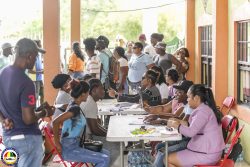The provision of school lunches has driven up attendance rates as well as raised performance and attentiveness in the hinterland, where an improvement in the overall nutritional diet of the more than 16,000 children benefiting has also been noticed, according to a recent World Bank assisted study.
The results of the community-based school feeding programme’s impact evaluation were released yesterday at the local World Bank Office via video conferencing with officials in the US.
The feeding programme targets 138 primary schools in the hinterland regions. How-ever, only 92 schools are actually providing school lunches on a daily basis; 31 in Region One, 24 in Region Seven, 17 in Region Eight, and 20 in Region Nine. Cumulatively, these represent 84 % of the target population.
The annual cost of this programme is $610,500,000 out of which $550 million is used for the provision of food stuff, while the remainder goes to training monitoring and other operations cost. The funds for this programme are provided by donor organizations, including the World Bank through the Global Partnership for Education Fund.
During brief remarks, Education Minister Priya Manickchand told those gathered that last year the Guyana Government spent over $1 billion on the national and hinterland school feeding programmes, which benefited over 63,000 children.
She said that a similar sum has been allocated for school feeding during this year, while noting that Minister of Finance Dr Ashni Singh had said in his budget speech that the current administration is committed to improving attendance, participation rates and attainment levels in the education sector.
One of the hinterland feeding programmes is a community-based programme under the Education For All-Fast Track Initiative (EFA-FTI), of the Ministry of Education, she said adding that this falls under Initiative Three – ‘Strengthening School and Community Collaboration.’
While the objective of this activity is to provide each primary school child in the hinterland with a balanced nutritious daily meal to ensure they attend school, she said that the broader goal is to have the school and community working closer together for the improvement of the children’s education.
In the quest to ensure equal access to education opportunities throughout the length and breadth of Guyana, she said 92 of hinterland primary schools are currently participating in the programme, benefiting approximately 16,000 children of an enrolled population of approximately 19,000.
According to Manickchand, participating schools are provided with $175 per day for each child enrolled and this money is used for the payment of all expenses associated with the provision of a daily nutritious meal, including cost of food, transportation, cooks’ stipends, among other things).
Most food supplies, she noted, are sourced from within the community and prepared by trained cooks from the community, “thereby contributing to economic benefits for the respective communities and the employment of women”.
She said that because Guyana has a sound Education Sector Develop-ment Plan, the ministry was able to benefit from grant funds from the Education For All Catalytic Fund, (now the Global Partnership for Education Fund). It is from this grant, she told the gathering, that the community based school feeding programme is funded.
The programme is managed by the EFA-FTI secretariat of the Ministry of Education and all stakeholders participating in the programme (cooks, treasurers of the school feeding committees, teachers and others) receive extensive training from personnel within the Ministry of Education, the Ministry of Health and in some cases, the Ministry of Agriculture, she said.
Further, Manickchand said, the programme has seen extensive collaboration between her ministry and other ministries and institutions, including donor partners such as the European Union, which provided funds for the construction of kitchens in some communities.
She said collaboration at the regional and community levels has also been remarkable and has demonstrated that communities have the enhanced educational opportunities of their children as a significant priority.
“As Guyana strives to achieve equal access to education and enhanced literacy and numeracy levels, it is encouraging to note that this programme has yielded some positive results and has been well received by most communities in which it is being implemented,” she said, adding that teachers have spoken about the positive impact of the programme on classroom performance of children.
There is a general belief, Manickchand said, that the programme has resulted in capacity enhancement at the community level. “Over the last year or so there has been an exciting initiative which is the provision of funds for projects in schools which are aimed at providing some of the inputs for the feeding programme,” she said, while adding that these projects if they are successful will reduce the cost of the programme and help to ensure its sustainability.
She described this project as the most closely monitored and well evaluated feeding programme in Guyana, noting that baseline data was established and data is gathered on an annual basis.
‘A positive impact’
Christian Borja-Vega, a World Bank consultant, noted that the programme is aligned with the Millennium Development Goals that deal with alleviation of hunger and the assurance that boys and girls complete primary school.
He said that one of the aims was to motivate and empower parents and teachers. There is also a short-term hunger alleviation purpose, he added, which is incorporated in the nutritional part of the programme.
Vega later noted that the hinterland communities have a higher rate of stunting, higher mortality rates and higher poverty than average and a lower health indicator when compared with their coastal counterparts. He said the objectives were to measure if the school feeding programme was improving these nutritional indicators overtime.
He said the issue of food security in Guyana is reflected in the lack of diet diversity, especially with vegetables, fruits and diary products.
During his presentation, Vega used graphs to show poverty region by region along with other data. He said that as a result of the programme, students enjoy improved school attendance, classroom responsiveness, nutritional status and overall academic performance. He said the evaluation found that at the community level, there was improved participation in school activities and improved household diets.
Vega noted that these are very important aspects of the programme as it was implemented a very adverse condition in terms of the food prices. He said that the evaluation looked at where the food was prepared, enrolment and attendance and the incentives for all involved.
He said the children’s health was assessed by changes in their height (stunting), weight (body mass) and nourishment status. During the evaluation, the focus was on a high quality and timely collection of data collection and in the end this was successfully done. The data was collected over a period of time including three surveys between 2007 and 2009, some through questionnaires.
He said school enrolment was increased by 16% between 2007 and 2009, while on the coastland it declined by 7.5%. He said this is a very serious development, especially in the context of a very serious situation with food prices during this period.
According to Vega, in terms of nutritional status, it was discovered that in the treatment areas, between 2007 and 2009, children grew .8 centimetres more compared to attending schools without the community based school feeding programme. Turning his attention to the classroom, Vega said that Science, Social Studies, English and Maths scores were higher when compared with the schools that were not in the programme.
He said head teachers and teachers at the participating schools have also noted that the attitudes of students had changed in a positive way.
Angela Demas, Senior Education Specialist at the World Bank, stated that based on the results received, the programme has had a positive impact. In 2010, she said, 12 communities that had implemented the school feeding programme were approached as it was felt that it was important to hear the views of community members. She said this was done to ascertain their needs and what they themselves could contribute to making the programme more sustainable. Demas told the gathering that during the consultations, the residents indicated that because of the programme children were more likely to stay the whole day rather than going home for lunch and not returning to school
Also present at the event were the ministry’s Chief Planning Officer Evelyn Hamilton and Edward Jarvis, EFA-FTI Coordinator.









